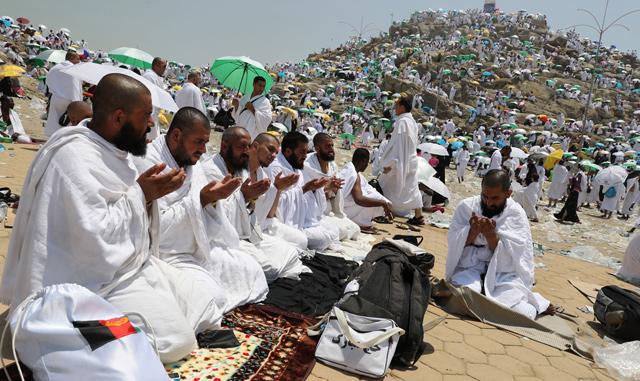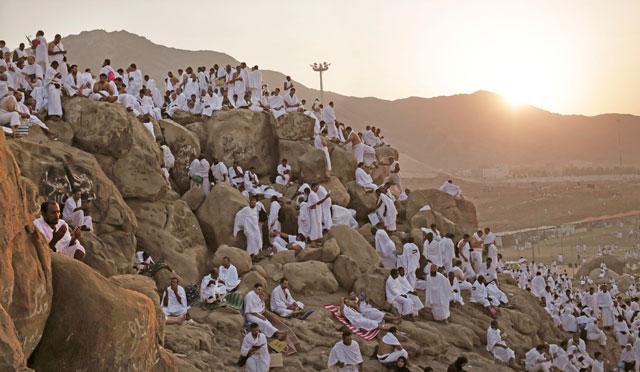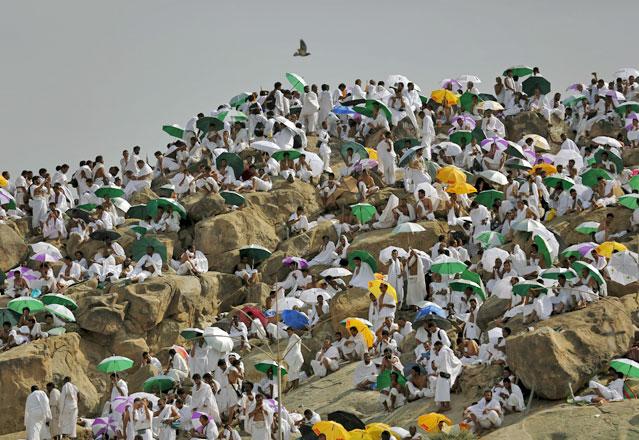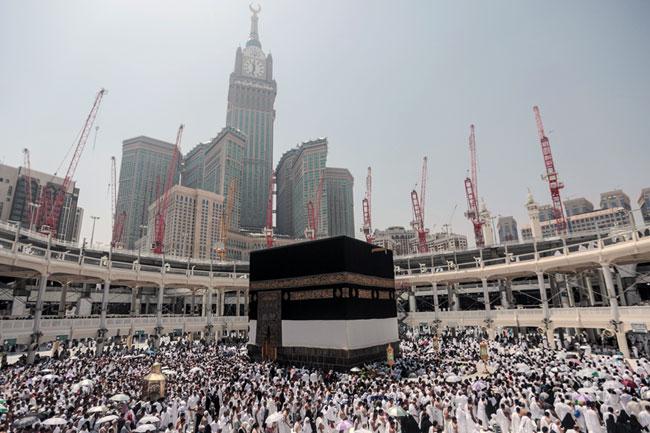You are here
Muslim pilgrims scale Mount Arafat for peak of Hajj
By AFP - Aug 20,2018 - Last updated at Aug 20,2018

Muslim pilgrims pray at Mount Arafat, also known as Jabal Al Rahma (Mount of Mercy), southeast of the Saudi holy city of Mecca, as the climax of the Hajj pilgrimage approaches on Monday (AFP photo)
MOUNT ARAFAT, KSA — A sea of pilgrims ascended Mount Arafat in Saudi Arabia on Monday to pray and repent, the climax of the annual Hajj bringing together more than two million Muslims from around the world.
Carrying brightly coloured umbrellas under the blazing sun, worshippers scaled the rocky hill southeast of the holy city of Mecca to atone for their sins.
Arms raised, pilgrims repeated “There is no God but Allah” and “Allahu Akbar” (God is greatest).
“The feeling is indescribable,” said Umm Ahmad, 61, who made the journey from Egypt.
Nearly 2.4 million Muslims made the trip to western Saudi Arabia, home to Islam’s holiest sites, according to the kingdom’s statistics authority.
Some of the pilgrims — men in white seamless garments and women in loose dresses — pushed elderly relatives in wheelchairs on the second day of the Hajj, one of the world’s largest annual gatherings.
Jai Saleem, a 37-year-old Pakistani, said he cried when he and his wife arrived on Mount Arafat, where Muslims believe Prophet Mohammed delivered his final sermon.
“It feels great,” he said. “I have always seen this area, since my childhood, in photographs and on television.”
After sunset prayers, pilgrims will make their way down Mount Arafat to Muzdalifah, another holy site where they will sleep under the stars to prepare for the final stage of Hajj, a symbolic “stoning of the devil” ritual.
Closer to Allah
Buses could be seen parked around the hill as workers hurriedly picked up empty water bottles near a yellow sign that read “Arafat starts here” in both English and Arabic.
“We know that it’s a difficult task,” said Amna Khan, a 35-year-old American Muslim pilgrim.
“That’s why we are all here. We’re doing this to get closer to Allah, to be absolved.”
A hot wind blew across the hill, also known as Jabal Al Rahma (Mount of Mercy), and the surrounding plain after a downpour late Sunday. Many faithful could be seen sipping from bottles of water throughout the day.
“I knew it would be a little hard to climb Mount Arafat,” said Nigerian pilgrim Saidou Boureima.
“So I prepared for this challenge by working out. And God willing, we can see it through.”
The Hajj is one of the five pillars of Islam which every Muslim is required to complete at least once in their lifetime if they are healthy enough and have the means to do so.
Iranian contingent
The Hajj has at times been a point of controversy, following an incident in 1987 in which Saudi police crushed an Iranian protest during the pilgrimage against the United States and Israel.
The clashes killed 402 people, including 175 Iranians, according to Saudi authorities.
Iran boycotted the Hajj in 2016, following a deadly stampede the year before which left some 2,300 dead, hundreds of them Iranian.
Tehran sent its pilgrims to Mecca in 2017, and the Hajj this year includes 86,000 Iranians, according to Mecca governor Prince Khaled Al Faisal.
Prince Khaled has also said this year’s Hajj includes 300 pilgrims from Qatar, a neighbouring emirate hit by a major Saudi-led boycott.
Saudi Arabia — the world’s largest exporter of oil — and its allies accuse Qatar of cosying up to both Sunni Islamist extremists and Shiite Iran, Riyadh’s main rival.
They have cut all ties with Qatar — which denies the charges — and banned all flights to and from Doha.
Qatar on Sunday said that its citizens were unable to take part in the Hajj because of the diplomatic dispute.
Muslims on Tuesday observe the first day of Eid Al Adha, or Feast of Sacrifice, which marks the end of the Hajj.
They traditionally slaughter sheep for the three-day Eid Al Adha, a tribute to the prophet Abraham’s sacrifice of a lamb after God spared Ishmael, his son.
They will consume some of the meat and give the rest to poor people unable to buy food.
Related Articles
MOUNT ARAFAT — The Hajj reached its high point Sunday when Muslims from across the world converged on a stony hill in Saudi Arabia, a year a
MOUNT ARAFAT, Saudi Arabia — Around two million Muslims on Wednesday poured into the vast Saudi plain where Prophet Mohammad is believed to
MECCA — Hundreds of thousands of Muslims from across the globe began the annual Hajj, the greater Muslim pilgrimage to Mecca, on Tuesday in














